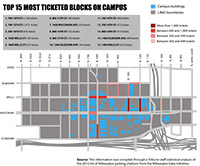While students and workers alike frolicked on their unexpected day off, last Wednesday’s snow day was an uphill struggle for clean-up crews.
In the heaviest snowfall to hit the area in nearly a dozen years, the “Groundhog Day blizzard” prompted early action to avoid even more troubles.
The City of Milwaukee received 18.2 inches of snow, said Paul Klajbor, the city’s administrative services manager.
For Marquette’s Department of Facilities Services, clearing the mess without a full staff on hand provided a challenge, said Ronald Ripley, the department’s director.
Ripley said he and Facilities Services acted on forecasts several days in advance to develop a game plan for how to attack the snow. The initial plan was to call in its ground staff Tuesday evening, but this idea was thwarted as the snow arrived, Ripley said.
“The plan didn’t work as well as we hoped, because the storm was so bad at that point,” Ripley said. “We (worked with) the staff that was on hand, which, initially, was less than the full staff.”
At least three people were on hand initially, he said. When the snow hit, the department focused on places that remained open, such as the library and residence halls, Ripley said.
“We’re responsible for the campus properties,” he said. “Classes were canceled, so where we started was on the north side of Wisconsin Avenue.”
The City of Milwaukee had its work cut out for it too as the blizzard rolled in. Much of Milwaukee’s Department of Public Works’ fleet of vehicles was fitted with snow-clearing equipment.
Snow plows were added to garbage trucks while some workers took packers (garbage trucks with plows) home for advance clearing Wednesday morning, Klajbor said.
“We had started doing prep work, putting plows on the vehicles, and started doing that on Monday,” Klajbor said. “We had also done some street-wide whitening — there was a snowstorm before the Groundhog Day blizzard. We’d put down as much salt as we could, that would buy a little bit of time.”
Salt is measured in tons, Klajbor said, but he didn’t have specifics on the amount of salt put down.
Klajbor said the city used 71 of their motion sensors, 125 of the packers and 20 additional pieces of equipment to clear the snow.
Wednesday morning was especially challenging for Facilities Services as additional crews were blighted by an inability to travel on the highway, Ripley said.
“A number on the grounds crew couldn’t arrive — highway travel was somewhat problematic soon after the snow had stopped,” Ripley said. “It took hours to dig out. From that point on, it became around the clock for about 24 hours with alternating crews.”
Both on-campus and in the city, crews worked in shifts to clear the mess.
Most private businesses were closed, and Klajbor said none requested the city’s assistance. He said he city does take special care for fire departments, police stations and hospitals.



